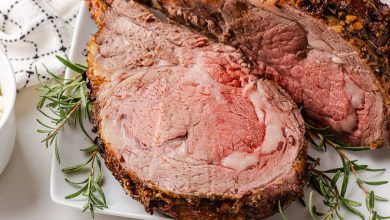Lamb (Australian, Fresh Raw Fat) – Nutritional Breakdown
Overview
Lamb, particularly the fresh raw fat from Australian-sourced lamb, is a rich and flavorful ingredient known for its tender texture and high-fat content. This specific cut offers an indulgent addition to various dishes, bringing a distinctive taste and richness, ideal for hearty recipes. Whether used in roasting, grilling, or braising, this lamb fat is often sought for its ability to enhance the flavor of dishes and provide a satisfying mouthfeel.
Nutritional Information
Here’s a breakdown of the nutritional values for 100g of Lamb (Australian, Fresh Raw Fat):
| Nutrient | Amount per 100g |
|---|---|
| Energy | 648 kcal |
| Protein | 6.27 g |
| Total Fat | 68.87 g |
| Saturated Fat | 35.35 g |
| Carbohydrates | 0.0 g |
| Fiber | 0.0 g |
| Sugar | 0.0 g |
| Calcium | 19 mg |
| Iron | 0.63 mg |
| Magnesium | 7 mg |
| Phosphorus | 71 mg |
| Potassium | 112 mg |
| Sodium | 33 mg |
| Zinc | 1.06 mg |
| Copper | 0.046 mcg |
| Manganese | 0.0 mg |
| Selenium | 4 mcg |
| Vitamin C | 0.0 mg |
| Thiamin (B1) | 0.057 mg |
| Riboflavin (B2) | 0.107 mg |
| Niacin (B3) | 1.753 mg |
| Vitamin B6 | 0.111 mg |
| Folate (B9) | 0.0 mcg |
| Vitamin B12 | 1.06 mcg |
| Vitamin A | 0.0 mcg |
| Vitamin E | 0.0 mg |
| Vitamin D2 | 0.0 mcg |
Health and Nutritional Insights
Lamb fat, while being a significant source of calories primarily from fat, also offers a substantial amount of protein. A 100g serving provides over 6 grams of protein, which can contribute to meeting daily protein requirements. However, it’s important to note that lamb fat is high in saturated fat, providing over 35 grams per 100g, which should be consumed in moderation as part of a balanced diet.
The micronutrient content of lamb fat includes calcium, iron, and phosphorus, all of which are essential for bone health. It also provides smaller amounts of magnesium, potassium, and zinc, which are important for various bodily functions, such as muscle function, nerve signaling, and immune support. Additionally, Vitamin B12 plays a key role in nerve function and red blood cell production, making this an important nutrient in lamb fat.
Dietary Considerations
- Allergen Information: Lamb fat itself does not typically pose common allergenic risks but may not be suitable for individuals following vegetarian, vegan, or halal diets.
- Dietary Preferences: Lamb is a rich source of fats, so it may not be ideal for low-fat, heart-health-focused, or weight-loss diets. However, it can be a valuable source of energy and essential nutrients for those following higher-fat diets, such as ketogenic or carnivore diets.
Cooking and Usage Tips
When incorporating lamb fat into your cooking, keep in mind that its high-fat content makes it an excellent cooking medium for frying, sautéing, or roasting. Its rich flavor can also be used to enhance stews, gravies, or sauces. However, due to its high fat levels, it is best to use it sparingly in your recipes to avoid overwhelming the dish. Lamb fat can also be rendered and used for basting meats or adding depth to vegetable dishes.
Conclusion
Lamb fat, especially from Australian-sourced lamb, offers a rich and flavorful option for enhancing a variety of dishes. While it provides a generous amount of protein and key micronutrients like zinc, phosphorus, and Vitamin B12, it is also high in saturated fats. Therefore, it is recommended to enjoy this ingredient in moderation, particularly in the context of balanced meals. Whether you’re roasting lamb shanks or adding depth to a savory stew, lamb fat is a distinctive and flavorful choice in the kitchen.










